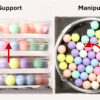A report from Australia’s chief scientist in 2016 highlighted a disparity between female and male science, technology, engineering, and mathematics (STEM)-qualified Aussies.
It found that fewer than one-third of STEM university graduates were female, with physics and astronomy, as well as engineering, having even lower proportions of female graduates.
Facing Senate Estimates last week, Australia’s Chief Scientist Dr Alan Finkel was questioned on the country’s progress. He said there was still a long way to go before the country would reach parity.
“It’s influenced enormously by home and parents. The decision for a young woman is influenced enormously by peer pressure, teachers, and role models, and there is a lot of effort … to try to redress it, but it takes time,” he said.
“There has been progress, but the rate of progress is very, very small.”
Must read: Revisiting the conversation about tech diversity and inclusion in Australia
He said the STEM workforce graduate figure for females was around 29% in 2016 and 27% five years earlier.
“It’s a move in the right direction, but a very small move,” he said.
Labor Senator Deborah O’Neill asked Finkel whether parity would be reached by 2091.
“Correct — hopefully earlier,” he said. “It’s not exactly clear what the real goal is. Is it parity in every single discipline, which is unreasonable, or is it gender parity across the whole totality of all the STEM disciplines? Or is it gender parity across all the professional disciplines, whether it is STEM or non-STEM?”
Finkel said political, educational, and business leaders needed to be clear about articulating what the goal is.
“At one extreme, it’s unreasonable, whether you’re looking at socioeconomic equivalents or gender equivalents, to think that in every narrow discipline you’ll get parity,” he added, agreeing also with O’Neill’s comments that there is a sociological and cultural element which is “extremely complex to disentangle”.
Finkel was asked why the country’s VET sector saw only 8% female participation in STEM-related study, versus the 29% present in the university sector. He said the types of qualifications available through VET were more male dominated — such as carpentry, plumbing, and electrical — while at university-level, more women have been entering the likes of biology and chemical engineering.
“There’s no easy way to compare the university STEM participation rates with the VET participation rates because the definitions are so different,” he said, noting the importance of keeping the narrative of university and VET separate. “When you combine them, I think the messages are confusing in both directions.
“You’ve got to have a clear definition of what the problem is and numbers that clearly articulate what the problem is before you can do anything.”



